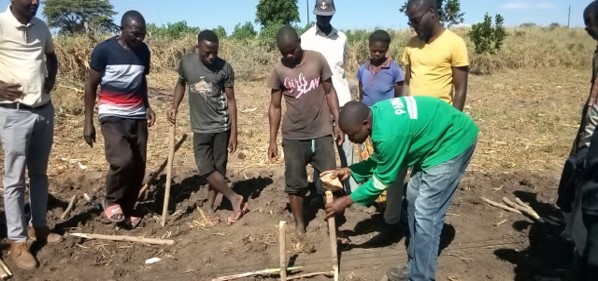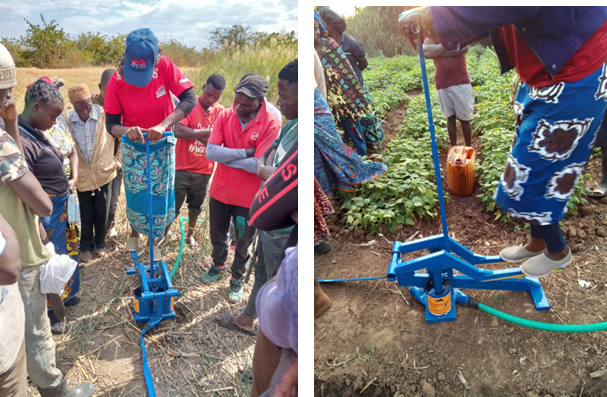As the effects of climate change intensify, rain dependent crop production is becoming more challenging for smallholder farmers in Malawi, Tanzania, and Zambia. Farmers often experience either too little or too much rain to effectively grow their crops, which means growing crops under irrigation is becoming key to building resilience to climate shocks. However, smallholder farmers often lack the access to equipment and skills to implement low-cost irrigation technologies.
The Accelerated Innovation Delivery Initiative (AID-I) implemented by the International Center for Maize and Wheat Improvement (CIMMYT) with funding from the United States Agency for International Development (USAID) has partnered with Total LandCare (TLC) Malawi and Zambia to promote Sustainable Intensification practices in Eastern and Central Malawi. TLC conducted a training session on using treadle pumps for irrigation plot layout in Mumbi Village, Petauke District, Zambia.

Letting gravity do the work
The irrigation system operates on the principle of pumping water manually from a low point to a high point from which the water then flows by gravity through a system of channels to irrigate crops.
Properly managed, treadle pump irrigation can improve household food security, income, nutrition, and health sustainably without detrimental effects to the environment.
The training educated 12 farmers in establishing an irrigation layout using gravity-fed basins, with water pumped from a stream downhill using a treadle pump. Participants learned how to erect channels that directed water into basins.
During practical irrigation training in Muya village of Mondolo camp, Petauke district, one of the farmers, Magret Tembo said, “This method of irrigation will negate the burden associated with use of watering cans, a practice which has been giving us backaches. Through this technology, we will experience increased production through better water management and increased area coverage.”
Following the setup demonstration, participants received practical guidance on various aspects of irrigation and crop management, covering such topics as planting techniques and effective fertilizer use, and application of pesticides and fungicides.
Inexpensive and durable
“Treadle pump irrigation offers tremendous opportunities to dramatically increase agricultural production while enriching the livelihoods of many resource-poor farmers,” said Zwide Jere, Co-founder/Managing Director of TLC.
Treadle pumps are inexpensive, so individuals can afford to purchase one and they are durable and easy to maintain, so one pump will work for years for individual households.
“The pumps are also designed to work in many environments,” said Paul Malambo, Country Manager for TLC Zambia. “So, over the years, TLC has been able to distribute the pumps in Malawi, Mozambique, Tanzania and Zambia.”

“Providing access to technical knowledge and support for under-utilized land, water and labor resources is an important part of the AID-I project, said Kevin Kabunda, CIMMYT lead for the AID-I. “As is collaboration with local partners like TLC who facilitate the dissemination of expertise.”
TLC is a registered non-governmental organization based in Malawi and active in Zambia. Its mission is to empower self-reliance and prosperity for rural households in the Southern Africa region.



